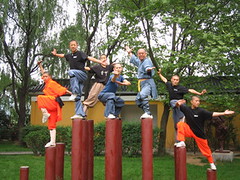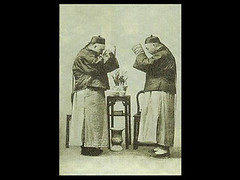| Home > Living in China > Kungfu |
Extensive Shaolin Kung-Fu
 |
|
Shaolin Kung-Fu |
According to records, the wushu practised at the monastery in different periods was varied in style and content. Among the unarmed combat styles were those resembling the fast and agile Chang Quan. Others were powerful, like Nan Quan, or emphasized the use of will and mind as well as breathing like Xingyi Quan (Will-Mind Boxing) and Rou Quan (Soft Boxing); still others imitated animal movements like Luohan Quan (Arhat Boxing) and Hou Quan (Monkey Boxing). Shaolin staff skills were especially famous, although all the eighteen military weapons were practised.
Shaolin Kung Fu is extensive. It consists of 36 external exercises and 36 internal exercises. They are called in combination the 72 hand-combat arts of Shaolin. Each kind of exercise has a very close relation with Qigong. Many other forms of exercise evolved, such as the Standing Pole Exercise, Hard Skills, Light Skills.
In the last years over 50 schools and institutions settled down outside of the shaolin temple teaching Shaolin Kung Fu. However most of the schools were destroyed and moved to Dengfeng or Zhengzhou.
Till today the Shaolin Kung Fu is the largest and most well-known martial art in China. A Chinese dialect says: "All styles of Kung Fu come from Shaolin, but the Shaolin Kung Fu is the best one."
In the last years over 50 schools and institutions settled down outside of the shaolin temple teaching Shaolin Kung Fu. However most of the schools were destroyed and moved to Dengfeng or Zhengzhou.
Art
 more
moreTea Wares Develop in Different

A Basic Knowledge about China
Pottery warriors Pottery may be the oldest

China’s Four Treasures of Study

Customs
 more
more



 print
print  email
email  Favorite
Favorite  Transtlate
Transtlate 
